Cancer constellation is located in the northern sky. Its name means “the crab” in Latin. Cancer is the faintest of the 12 zodiac constellations. Its symbol is ♋. The constellation was first catalogued by the Greek astronomer Ptolemy in his Almagest in the 2nd century CE.
In Greek mythology, the constellation Cancer is associated with the crab sent by Hera to defeat Heracles. In different versions of the myth, the crab is either kicked into the sky by Heracles or placed among the stars by Hera after getting crushed by the Greek hero.
Cancer contains a number of famous deep sky objects, among them the open cluster Praesepe, also known as the Beehive Cluster (Messier 44), the open cluster Messier 67, and the interacting spiral galaxies NGC 2535 and NGC 2536.
Facts, location and map
Cancer is the 31st largest constellation in the sky, occupying an area of 506 square degrees. It lies in the second quadrant of the northern hemisphere (NQ2) and can be seen at latitudes between +90° and -60°. The neighboring constellations are Canis Minor, Gemini, Hydra, Leo, Leo Minor, and Lynx.
The constellation name Cancer is pronounced /ˈkænsər/. In English, the constellation is known as the Crab. The genitive form of Cancer, used in star names, is Cancri (pronunciation: /ˈkæŋkraɪ/). The three-letter abbreviation, adopted by the International Astronomical Union (IAU) in 1922, is Cnc.
Cancer belongs to the zodiac family of constellations, along with Aries, Taurus, Gemini, Leo, Virgo, Libra, Scorpius, Sagittarius, Capricornus, Aquarius, and Pisces.
Cancer contains two Messier objects – the Beehive Cluster (M44, NGC 2632) and M67 (NGC 2682) – and has two stars with known planets. The brightest star in the constellation is Al Tarf, Beta Cancri. The Delta Cancrids are the only meteor shower associated with the constellation.
Cancer contains 11 named stars. The proper names of stars that have been officially approved by the International Astronomical Union (IAU) are Acubens, Asellus Australis, Asellus Borealis, Copernicus, Gakyid, Kaewkosin, Meleph, Nahn, Piautos, Tarf, and Tegmine.
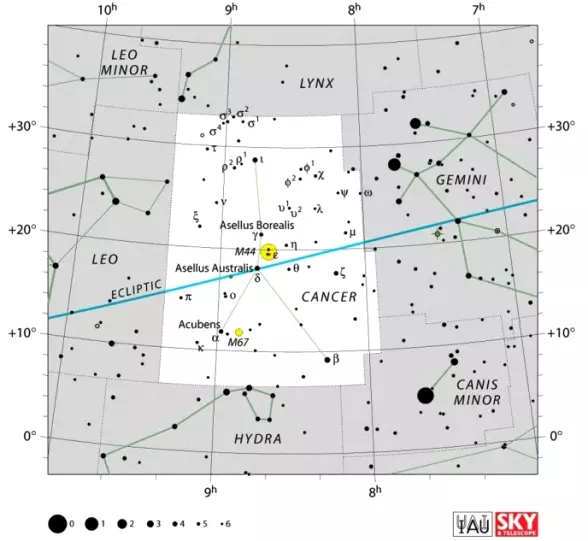
Cancer constellation map by IAU and Sky&Telescope magazine
Myth
In mythology, Cancer is associated with the crab in the story of the Twelve Labours of Heracles (represented by the Hercules constellation). In the myth, Hera sends the crab to distract Hercules while the hero is fighting the Lernaean Hydra, the serpent-like beast with many heads and poisonous breath, represented by Hydra constellation. When the crab approaches Hercules, the hero kicks it all the way to the stars.
In another version, the crab gets crushed instead and Hera, a sworn enemy of Hercules, places it in the sky for its efforts. However, she places the crab in a region of the sky that has no bright stars, because despite its efforts, the crab was not successful in accomplishing the task. Cancer does not have any stars brighter than fourth magnitude.
Cancer stars
Acubens – α Cancri (Alpha Cancri)
Acubens, Alpha Cancri, is only the fourth brightest star in Cancer. Its apparent magnitude varies between 4.20 and 4.27.
The star is sometimes also called Al Zubanah or Sertan. The name Al Zubanah comes from the Arabic az-zubānah, which means “claws,” while Sertan is derived from saraţān, which means “the crab.”
Alpha Cancri is a multiple star system located approximately 174 light years from Earth. The brightest component, Alpha Cancri A, is a white A-type main sequence dwarf. The star has an eleventh magnitude companion, Alpha Cancri B. The brighter star in the system is suspected to be a very close binary itself, consisting of two stars separated by 0.1 arc seconds.
Acubens belongs to the spectral class A5m and has a luminosity 23 times that of the Sun. The star lies close to the ecliptic and can be occulted by the Moon and, rarely, by planets.
Tarf – β Cancri (Beta Cancri)
Beta Cancri is the brightest star in the constellation, with an apparent magnitude of 3.5. It is a binary star that consists of an orange K-type giant and a fourteenth magnitude companion 29 arc seconds away. Beta Cancri is approximately 290 light years distant.
The star’s traditional name, Al Tarf (or just Tarf), is believed to be derived either from the Arabic aṭ-ṭarf, which means “the eye,” or aṭ-ṭarfah, which means “the glance (of Leo).”
Asellus Australis – δ Cancri (Delta Cancri)
Delta Cancri is an orange giant with an apparent magnitude of 3.94. It is 180 light years distant. It is the second brightest star in Cancer. It marks the location of Praesepe (Messier 44), the famous open cluster, also known as the Beehive Cluster.
The star is also notable for its less famous name, Arkushanangarushashutu, which is the longest of all the known star names. It means “the southeast star in the Crab” in ancient Babylonian.
The more commonly used name, Asellus Australis, means “southern donkey colt” in Latin.
Delta Cancri also lies close to the ecliptic and can be occulted by the Moon and, however rarely, by planets.
Asellus Borealis – γ Cancri (Gamma Cancri)
Gamma Cancri is a white A-type subgiant approximately 158 light years distant. It has an apparent magnitude of 4.66. The star’s traditional name, Asellus Borealis, means “northern donkey colt.” Like Alpha and Delta Cancri, Gamma Cancri is also located near the ecliptic and can be occulted.
Delta and Gamma Cancri, the northern and southern donkey, are usually associated with an old Greek myth. Erastosthenes wrote that, in the war between the gods and the Giants that came after the clash with the Titans, the gods Hephaestus, Dionysus and several others rode on donkeys into battle. The Giants, who had never heard a donkey bray, thought the donkeys were monsters and fled. Dionysus later placed the donkeys in the sky to commemorate the event. He put them next to a star cluster which the Greeks called the Manger (Phatne). The cluster is now known as Praesepe or, more popularly, the Beehive Cluster. (In Latin, praesepe can mean both “hive” and “manger.”)
55 Cancri
55 Cancri is a double star that consists of a yellow main sequence dwarf belonging to the spectral class G8V and a 13th magnitude red dwarf that can only be seen through a telescope. The system is approximately 41 light years distant.
55 Cancri is notable because, as of 2010, astronomers have confirmed five extrasolar planets orbiting the primary star in the system, 55 Cancri A. This is one of the four known planetary systems known to have at least five planets. (Others are our solar system, Gliese 581 in the constellation Libra and HD 10180 in Hydrus.) The planet nearest to the star is believed to be a terrestrial planet with a mass similar to Neptune, while the outermost planets are believed to be Jovian planets, with masses comparable to that of Jupiter.
Tegmine – ζ Cancri (Zeta Cancri)
Zeta Cancri is a multiple star system approximately 83.4 light years from Earth. It contains at least four stars. Its traditional name, Tegmine, means “the shell of the crab.” The system has an apparent magnitude of 4.67.
Zeta Cancri is composed of two binary stars, Zeta-1 Cancri and Zeta-2 Cancri, separated by 5.06 arc seconds. The first pair, Zeta Cancri A and Zeta Cancri B, consists of yellow-white F-type main sequence dwarfs. They are separated by 1 arc second in the sky. The second pair, Zeta Cancri C and Zeta Cancri D, consists of a yellow G-type star and a 10th magnitude red dwarf separated by only 0.3 arc seconds. They have an orbital period of 17 years.
λ Cancri (Lambda Cancri)
Lambda Cancri is a blue-white B-type main sequence dwarf, approximately 419 light years distant. It has an apparent magnitude of 5.92.
ξ Cancri (Xi Cancri)
Xi Cancri is a spectroscopic binary star approximately 381 light years distant. It is sometimes also known as Nahn.
The Xi Cancri system consists of Xi Cancri A, a yellow G-type giant with a magnitude of 5.16, and Xi Cancri B, a companion star located only 0.1 arc seconds away. The stars have an orbital period of 4.66 years.
Deep sky objects in Cancer
Beehive Cluster (Praesepe, Messier 44, M44, NGC 2632)
The Beehive Cluster is an open star cluster about 577 light years from Earth. It is one of the nearest and most populated open clusters to the solar system. It has an apparent magnitude of 3.7 and its estimated age is 600 million years. The Beehive Cluster is also called Praesepe, which means “the manger” in Latin.
The cluster is visible to the unaided eye. The Greek astronomer Ptolemy observed it and called it “the nebulous mass in the breast of Cancer.” Galileo was the first to see in through a telescope in 1609, and Charles Messier added the cluster to his catalogue in 1769.
Praesepe contains at least a thousand stars. More than a half of them (63%) are red dwarfs, and about a third (30%) of the stars are Sun-like, classified as F, G and K-class stars. The brightest stars in the cluster are blue-white in colour and with magnitudes ranging between 6 and 6.5.
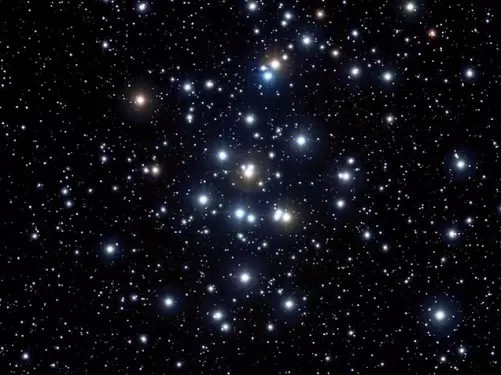
Messier 44 – the Beehive Cluster, image: Giuseppe Donatiello (CC0 1.0)
Messier 67 (M67, NGC 2682)
Messier 67 is an open cluster. It is one of the oldest open clusters known. Its estimated age is between 3.2 and 5 billion years.
The cluster was discovered by the German astronomer Johann Gottfried Koehler in 1779. It has an apparent magnitude of 6.1.
M67 contains over 100 stars similar to the Sun and a number of red giants. Almost all the stars in the cluster are roughly at the same distance and of the same age (with the exception of 30 or so blue stragglers), which makes M67 one of the most observed and studied objects by those studying stellar evolution.
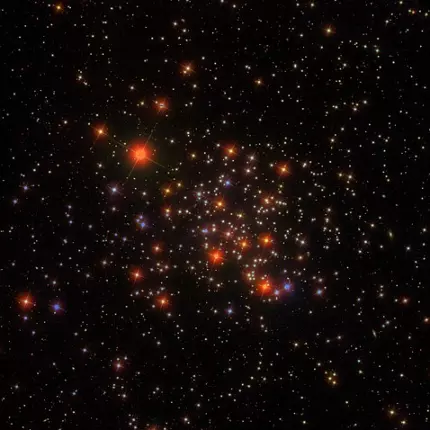
Messier 67, image: Sloan Digital Sky Survey
NGC 2775 (Caldwell 48)
NGC 2775 is a spiral galaxy, approximately 55.5 million light years from Earth. It has an apparent magnitude of 11.03. The galaxy was discovered by William Herschel in 1783. It has multiple spiral arms with few HII regions, which means there was recent star forming activity occurring in it.
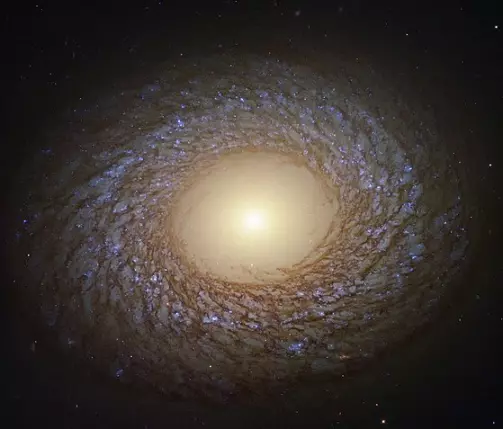
This Hubble image shows a flocculent spiral galaxy called NGC 2775. The image was made from separate exposures taken in the visible, ultraviolet and near-infrared regions of the spectrum with Hubble’s Wide Field Camera 3 (WFC3). It is based on data obtained through five filters. The color results from assigning different hues to each monochromatic image associated with an individual filter. Image credit: NASA/ESA/Hubble/J. Lee/PHANGS-HST Team/Judy Schmidt, www.geckzilla.com.
NGC 2535 and NGC 2536
NGC 2535 and NGC 2536 are spiral galaxies in Cancer that are interacting with each other. NGC 2535 is an unbarred spiral with an apparent magnitude of 16.9, while NGC 2536 is a barred spiral galaxy with a magnitude of 14.6.
NGC 2608 (Arp 12)
NGC 2608 is a barred spiral galaxy, 62,000 light years across, with an apparent magnitude of 13.01. It is classified as SB(s)b, which means that its spiral arms wind moderately around the prominent central bar. NGC 2608 is considered a grand design spiral galaxy. It is approximately 93 million light years distant.
Two supernovae were observed in the area in recent history. SN 1920A peaked at magnitude 11.7 in December 1920 and SN 2001bg was spotted in May 2001 and later peaked at magnitude 13.7.
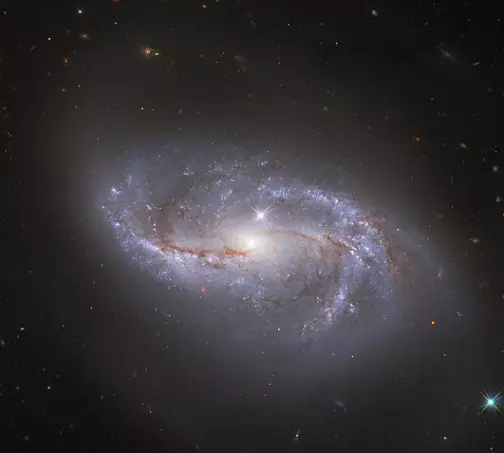
Looking deep into the Universe, the NASA/ESA Hubble Space Telescope catches a passing glimpse of the numerous arm-like structures that sweep around this barred spiral galaxy, known as NGC 2608. Appearing as a slightly stretched, smaller version of our Milky Way, the peppered blue and red spiral arms are anchored together by the prominent horizontal central bar of the galaxy. In Hubble photos, bright Milky Way stars will sometimes appear as pinpoints of light with prominent lens flares. A star with these features is seen in the lower right corner of the image, and another can be spotted just above the pale centre of the galaxy. The majority of the fainter points around NGC 2608, however, lack these features, and upon closer inspection they are revealed to be thousands of distant galaxies. NGC 2608 is just one among an uncountable number of kindred structures. Image: ESA/Hubble & NASA, A. Riess et al.